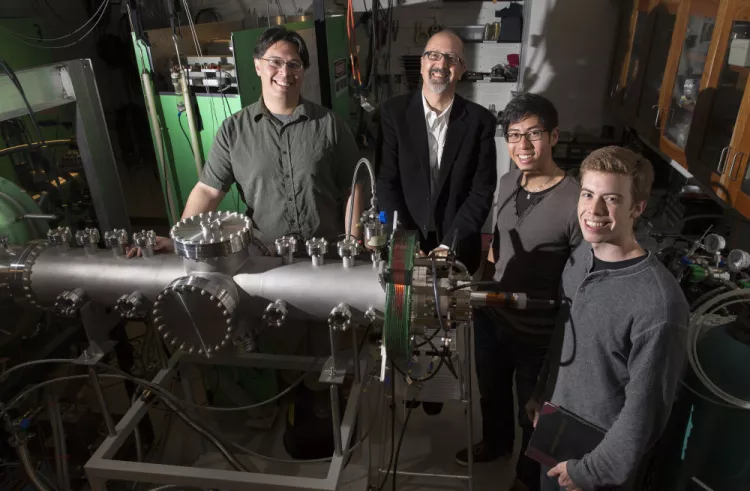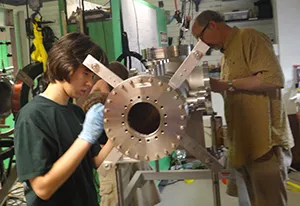Grappling with the Unknown

Teamwork in Swarthmore's plasma physics lab leads to learning opportunities for both students and faculty. Here (from left), postdoctoral researcher David Schaffner, Department of Physics & Astronomy Chair Michael Brown, Adrian Wan '15, and Peter Weck '15 with the wind tunnel in the turbulence and plasma physics laboratory.
The first thing Adrian Wan ’15 learned was how little he knew.
His introduction to the Swarthmore Spheromak Experiment (SSX) Lab — in which an ever-growing team of faculty and students explores astrophysical phenomena — was, to drop some shoptalk, turbulent.
“I just remember feeling really lost,” says Wan, a physics and computer science major from Hong Kong Island, Hong Kong. “I had so many papers to read up on before I could even get started.”

Emily Hudson '17 tightens bolts on the extension chamber of the wind tunnel. The Greenville, S.C., native studied the velocity of plasma plumes last summer through the Vandervelde-Cheung Scholarship.
Wan began collecting and analyzing data as part of a team examining the turbulent intermittency in a plasma wind tunnel. Interaction with and guidance from Michael Brown, professor of physics and chair of the Department of Physics & Astronomy, and David Schaffner, postdoctoral researcher, shortened his learning curve.
Wan marveled at his colleagues’ know-how. But it was what they didn’t know that really resonated for him.
“It amazed me that you could spend 10 or 20 years in this field and still grapple with so many unknowns,” he says. “That was a humbling experience.”
Wan expected to gain experience in academic research that summer, but he came away with much more. He co-authored a paper with Brown and Schaffner that was published in the preeminent physics journal Physical Review Letters in April and was cited among a handful of outstanding undergraduates for his poster at the annual American Physical Society Division of Plasma Physics (APS-DPP) meeting in Denver, Colo.
“I was really just overwhelmed and thankful to have this kind of opportunity as an undergrad,” he says. “I can’t imagine that’s the case at many other places.”
It’s not unusual at Swarthmore, however, where the SSX lab celebrates its 20th year of cutting-edge research into plasma physics. Brown has guided over 40 undergrads through all aspects of the scientific research process, from designing and conducting experiments to writing papers.
“Students see first-hand how science really works from start to finish,” he says, “and [the field] benefits from the insights provided by these bright young scientists.”
Among them is Peter Weck ’15, who this summer used a relatively new type of math to compare fluctuations in plasmas found in the solar wind. The data offers another point of comparison between what’s happening in the solar wind and what Brown and his team recreate in the lab’s plasma wind tunnel, says Weck, an Honors physics student from Columbia, Ill., who treasured the opportunity.

Peter Weck '15 presents his research at undergraduate poster session of the the American Physical Society Division of Plasma Physics annual meeting in New Orleans, La., in October.
“I’ve had internships at other schools and done grunt work in labs, but this was the first time I actually got deeply involved in the core of the research and had some level of independence,” he says. “It was a great experience, both for what I learned and the confidence I gained.”
Weck’s efforts culminated in a paper he co-authored with Brown, Schaffner, and Robert Wicks of the NASA Goddard Space Flight Center that examines permutation entropy and the statistical complexity of a time series signal. Submitted to Physical Review E, the paper is one of eight the SSX team has offered to the scientific community in the past year.
“In doing science, it’s critical to share your results in the published literature,” says Brown, noting that peer reviewers strengthen the value of findings for the scientific community.
Because plasmas constitute most of the solar system, Wan says, these findings may appeal not only to physicists but anyone pondering bigger questions.
“We’re curious as to whether the plasmas we create in the lab are similar or different in some respects as those in the sun and stars,” he says. “Is there something that ties them all together? Understanding that would give us a much better understanding of the universe.”
Exploring these avenues doesn’t necessarily require a Ph.D. in physics or math, says Schaffner. But it does take hard work and initiative — traits he has consistently seen from the students he directs.
“I like to brag about my Swarthmore undergrads,” says Schaffner. “They’re very well prepared to do high-level, cutting-edge research.”
He counts Wan and Weck among the best, as much for their self-motivation as their technical prowess.
“I’d give them a little bit of material, and they’d go and seek things out on their own,” he says. “Then they’d come back and tell me what they learned, and I would learn from them, and we’d iterate on that. It was more like having a research colleague than someone you were mentoring.”



